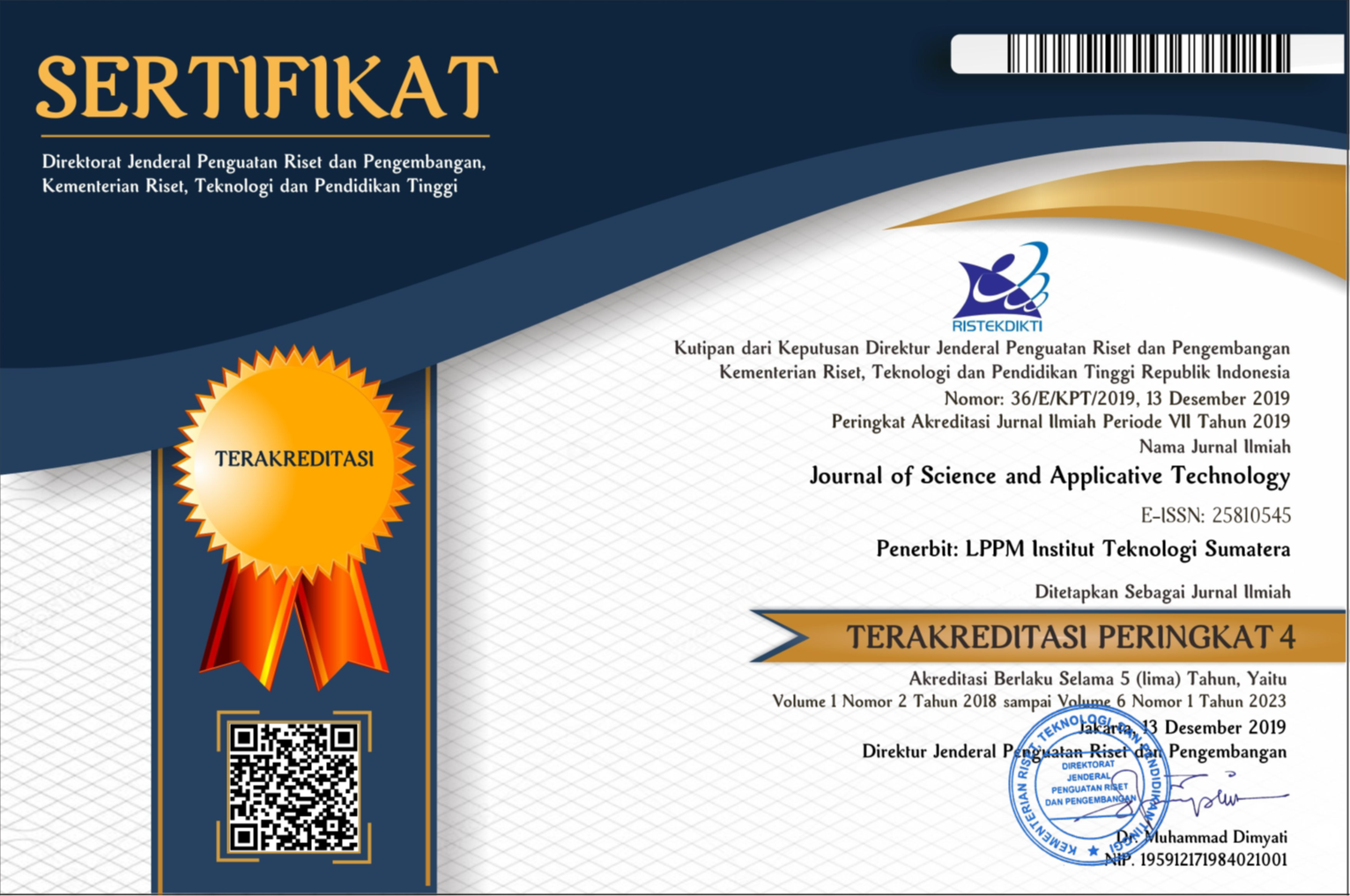Study of Thermoelectric Generator Utilization to Recover Heat at Low Temperature Grade Application: A Review
Abstract
Generally, the supply of heat energy is abundant in this world especially from direct solar radiation or combustion process activity. However, this energy is mostly wasted and discharged to the environment without recovery and re-utilization process. There is a potential utilization this heat to be converted to electricity using thermoelectric generator (TEGs). This technology device has an ability to convert heat to electricity by difference temperature from both surfaces. This device could prevent thermal loss to environment and optimize the system to generate electricity for small and micro scale power generation. This research conducts a literature review about identifying several potential object application or equipment as heat sources from solar energy or combustion activity combine with thermoelectric generator at low grade temperature that has been worked by previous researcher for past 5 years. Current status and working principal of thermoelectric generator is presented briefly. Several parameters such as working temperature range, potential output power, and efficiency system are described and presented. Then, some implementation challenge and opportunity development combination TEGs with each object applications are discussed and analyzed to produce recommendation for further research
Downloads
References
[2] S. Bruckner, S. Liu, M. Laia, M. Radspieler, L.F. Cabeza, L. Eberhard, Industrial waste heat recovery technologies: an economic analysis of heat transformation technologies, Appl. Energy 151 (1) (2015) 157–167.
[3] S. Rana, B.Orr, A. Iqbal, L.C. Ding, A. Akbarzadeh, A.Date, Modelling and optimization of low temperature waste heat temperature generator system, Energy Procedia 110 (2017) 196–201.
[4] S. Mohsen, M. Hossein, and M. Sadeghzadeh, “Thermoelectric cooler and thermoelectric generator devices: A review of present and potential applications, modeling and materials,” Energy, vol. 186, p. 115849, 2019, doi: 10.1016/j.energy.2019.07.179.
[5] D. Champier, “Thermoelectric generators: A review of applications,” Energy Convers. Manag., vol. 140, pp. 167–181, 2017, doi: 10.1016/j.enconman.2017.02.070.
[6] L. C. Ding, A. Akbarzadeh, B. Singh, and M. F. Remeli, “Feasibility of electrical power generation using thermoelectric modules via solar pond heat extraction,” Energy Convers. Manag., vol. 135, pp. 74–83, 2017, doi: 10.1016/j.enconman.2016.12.069.
[7] N. Fadliah Baso, I. C. Gunadin, and Yusran, “Solar Pond Potential as A New Renewable Energy in South Sulawesi,” J. Phys. Conf. Ser., vol. 979, no. 1, 2018, doi: 10.1088/1742-6596/979/1/012039.
[8] L. C. Ding, A. Akbarzadeh, and L. Tan, “A review of power generation with thermoelectric system and its alternative with solar ponds,” Renew. Sustain. Energy Rev., vol. 81, no. July 2017, pp. 799–812, 2018, doi: 10.1016/j.rser.2017.08.010.
[9] L. C. Ding, A. Akbarzadeh, A. Date, and D. J. Frawley, “Passive small scale electric power generation using thermoelectric cells in solar pond,” Energy, vol. 117, pp. 149–165, 2016, doi: 10.1016/j.energy.2016.10.085.
[10] L. C. Ding, A. Akbarzadeh, and A. Date, “Transient model to predict the performance of thermoelectric generators coupled with solar pond,” Energy, vol. 103, pp. 271–289, 2016, doi: 10.1016/j.energy.2016.02.124.
[11] L. C. Ding, A. Akbarzadeh, and A. Date, “Electric power generation via plate type power generation unit from solar pond using thermoelectric cells,” Appl. Energy, vol. 183, pp. 61–76, 2016, doi: 10.1016/j.apenergy.2016.08.161.
[12] B. M. Ziapour, M. Saadat, V. Palideh, and S. Afzal, “Power generation enhancement in a salinity-gradient solar pond power plant using thermoelectric generator,” Energy Convers. Manag., vol. 136, pp. 283–293, 2017, doi: 10.1016/j.enconman.2017.01.031.
[13] X. Zhu, Y. Yu, and F. Li, “A review on thermoelectric energy harvesting from asphalt pavement: Configuration, performance and future,” Constr. Build. Mater., vol. 228, p. 116818, 2019, doi: 10.1016/j.conbuildmat.2019.116818.
[14] M. Gholikhani, H. Roshani, S. Dessouky, and A. T. Papagiannakis, “A critical review of roadway energy harvesting technologies,” Appl. Energy, vol. 261, no. December 2019, p. 114388, 2020, doi: 10.1016/j.apenergy.2019.114388.
[15] J. Pei, F. Guo, J. Zhang, B. Zhou, Y. Bi, and R. Li, “Review and analysis of energy harvesting technologies in roadway transportation,” J. Clean. Prod., vol. 288, p. 125338, 2021, doi: 10.1016/j.jclepro.2020.125338
[16] L. Guo and Q. Lu, “Potentials of piezoelectric and thermoelectric technologies for harvesting energy from pavements,” Renew. Sustain. Energy Rev., vol. 72, no. November 2016, pp. 761–773, 2017, doi: 10.1016/j.rser.2017.01.090.
[17] W. Jiang et al., “Energy harvesting from asphalt pavement using thermoelectric technology,” Appl. Energy, vol. 205, no. February, pp. 941–950, 2017, doi: 10.1016/j.apenergy.2017.08.091.
[18] W. Jiang, J. Xiao, D. Yuan, H. Lu, S. Xu, and Y. Huang, “Energy & Buildings Design and experiment of thermoelectric asphalt pavements with power-generation and temperature-reduction functions,” vol. 169, pp. 39–47, 2018, doi: 10.1016/j.enbuild.2018.03.049.
[19] S. A. Tahami, M. Gholikhani, R. Nasouri, S. Dessouky, and A. T. Papagiannakis, “Developing a new thermoelectric approach for energy harvesting from asphalt pavements,” Appl. Energy, vol. 238, no. January, pp. 786–795, 2019, doi: 10.1016/j.apenergy.2019.01.152.
[20] H. Roshani, S. Dessouky, A. Montoya, and A. T. Papagiannakis, “Energy harvesting from asphalt pavement roadways vehicle-induced stresses: A feasibility study,” Appl. Energy, vol. 182, pp. 210–218, 2016, doi: 10.1016/j.apenergy.2016.08.116
[21] A. E. Putra, R. Rifky, and A. Fikri, “Pemanfaatan Panas Buang Atap Seng dengan Menggunakan Generator Termoelektrik sebagai Sumber Energi Listrik Terbarukan,” Pros. Semin. Nas. Teknoka, vol. 3, no. 2502, p. 38, 2019, doi: 10.22236/teknoka. v3i0.2911.
[22] Ziolkowski A. Automotive thermoelectric generator impact on the efficiency of a drive system with a combustion engine. MATEC Web Conf 2017; 118:00024.
[23] M. Aljaghtham and E. Celik, “Design optimization of oil pan thermoelectric generator to recover waste heat from internal combustion engines,” Energy, vol. 200, p. 117547, 2020, doi: 10.1016/j.energy.2020.117547.
[24] S. Arumugam, P. Ramakrishna, S. Sangavi, and G. Sriram, “Thermoelectric analysis of automobiles exhaust waste heat recovery material - A simulation study,” Mater. Today Proc., vol. 16, pp. 516–523, 2019, doi: 10.1016/j.matpr.2019.05.123.
[25] P. Fernández-Yáñez, O. Armas, R. Kiwan, A. G. Stefanopoulou, and A. L. Boehman, “A thermoelectric generator in exhaust systems of spark-ignition and compression-ignition engines. A comparison with an electric turbo-generator,” Appl. Energy, vol. 229, no. July, pp. 80–87, 2018, doi: 10.1016/j.apenergy.2018.07.107.
[26] M. N. H. M. Hilmin, M. F. Remeli, B. Singh, and N. D. N. Affandi, “Thermoelectric power generations from vehicle exhaust gas with TiO2 nanofluid cooling,” Therm. Sci. Eng. Prog., vol. 18, no. March, 2020, doi: 10.1016/j.tsep.2020.100558.
[27] C. T. Hsu, G. Y. Huang, H. S. Chu, B. Yu, and D. J. Yao, “Experiments and simulations on low-temperature waste heat harvesting system by thermoelectric power generators,” Appl. Energy, vol. 88, no. 4, pp. 1291–1297, 2011, doi: 10.1016/j.apenergy.2010.10.005.
[28] T. Y. Kim, A. A. Negash, and G. Cho, “Waste heat recovery of a diesel engine using a thermoelectric generator equipped with customized thermoelectric modules,” Energy Convers. Manag., vol. 124, pp. 280–286, 2016, doi: 10.1016/j.enconman.2016.07.013.
[29] Z. G. Shen, L. L. Tian, and X. Liu, “Automotive exhaust thermoelectric generators: Current status, challenges and future prospects,” Energy Convers. Manag., vol. 195, no. June, pp. 1138–1173, 2019, doi: 10.1016/j.enconman.2019.05.087.
[30] R. Stobart, M. A. Wijewardane, and Z. Yang, “Comprehensive analysis of thermoelectric generation systems for automotive applications,” Appl. Therm. Eng., vol. 112, pp. 1433–1444, 2017, doi: 10.1016/j.applthermaleng.2016.09.121.
[31] R. Sukarno, “Pemanfaatan Panas Gas Buang Sepeda Motor,” pp. 149–156, 2016.
[32] Y. Wang, C. Dai, and S. Wang, “Theoretical analysis of a thermoelectric generator using exhaust gas of vehicles as heat source,” Appl. Energy, vol. 112, pp. 1171–1180, 2013, doi: 10.1016/j.apenergy.2013.01.018.
Copyright (c) 2021 Journal of Science and Applicative Technology

This work is licensed under a Creative Commons Attribution-NonCommercial 4.0 International License.
All the content on Journal of Science and Applicative Technology (JSAT) may be used under the terms of the Creative Commons Attribution-NonCommercial 4.0 International License.
You are free to:
- Share - copy and redistribute the material in any medium or format
- Adapt - remix, transform, and build upon the material
Under the following terms:
- Attribution - You must give appropriate credit, provide a link to the license, and indicate if changes were made. You may do so in any reasonable manner, but not in any way that suggests the licensor endorses you or your use.
- NonCommercial - You may not use the material for commercial purposes.
- No additional restrictions - You may not apply legal terms or technological measures that legally restrict others from doing anything the license permits.





















